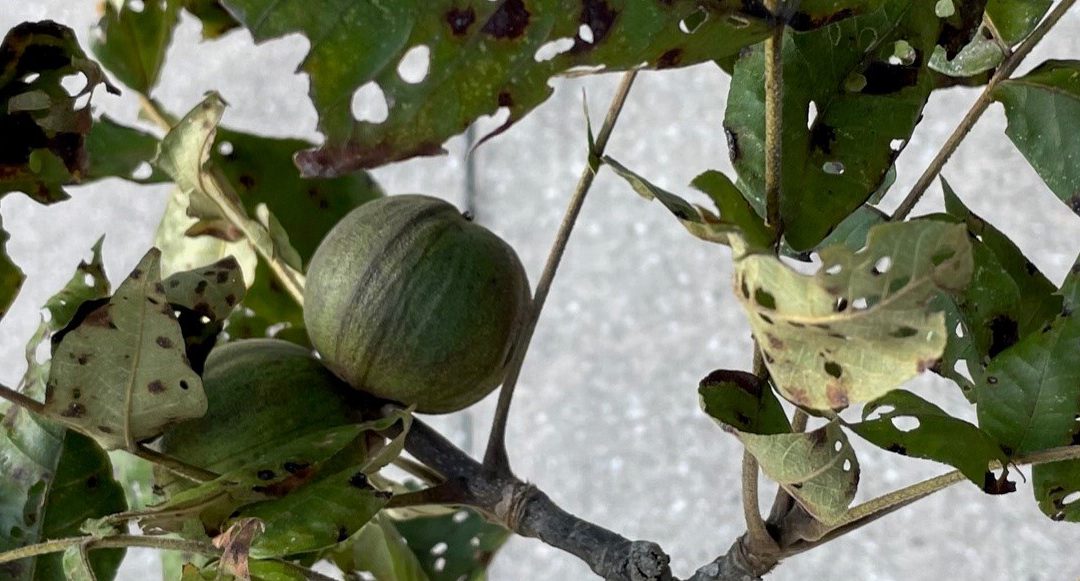
by Pat Williams | Sep 9, 2021
As homeowners, we do value our trees and no one wants to lose a shade tree especially on the house’s south side in Florida. On a recent site visit, a hickory tree had multiple concerns. Upon closer inspection, the tree had a bacterial infection about 30” off the ground with a smelly, black-brown ooze seeping forth. The leaf canopy was riddled with beetle holes and leaf margins were chewed by caterpillars. When leaves were viewed under the microscope, thrips (insects) and spider mites were found running around. The biggest homeowner cosmetic concern arose from hickory anthracnose (fungus) and upon closer inspection found the leaves to have hickory midge fly galls. The obvious question is should the tree come down? I’ll have you read the whole article before giving you the answer.
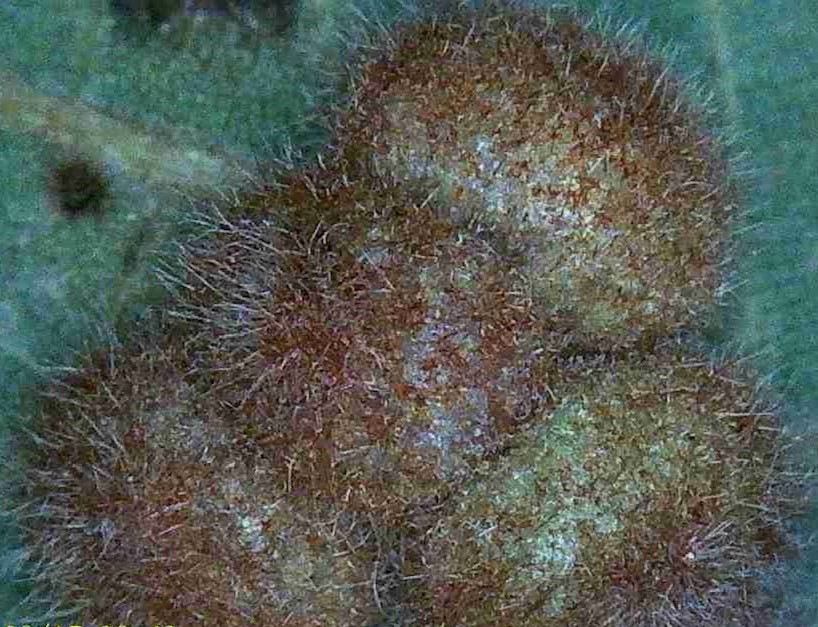
Each hickory gall is approximately 3/16″ wide.
Hickory anthracnose or leaf spot as seen in the banner photo is caused by a fungal infection during the wet summer months in Florida. The homeowner can usually recognize the disease by the large reddish brown spots on the upper leaf surface (sending a sample to the NFREC Plant Pathology Lab will confirm the diagnosis) and brownish spots with no formal shape on the bottom. Be sure to rake and remove all leaves to prevent your disease from overwintering close to the tree thus reducing infection next year.
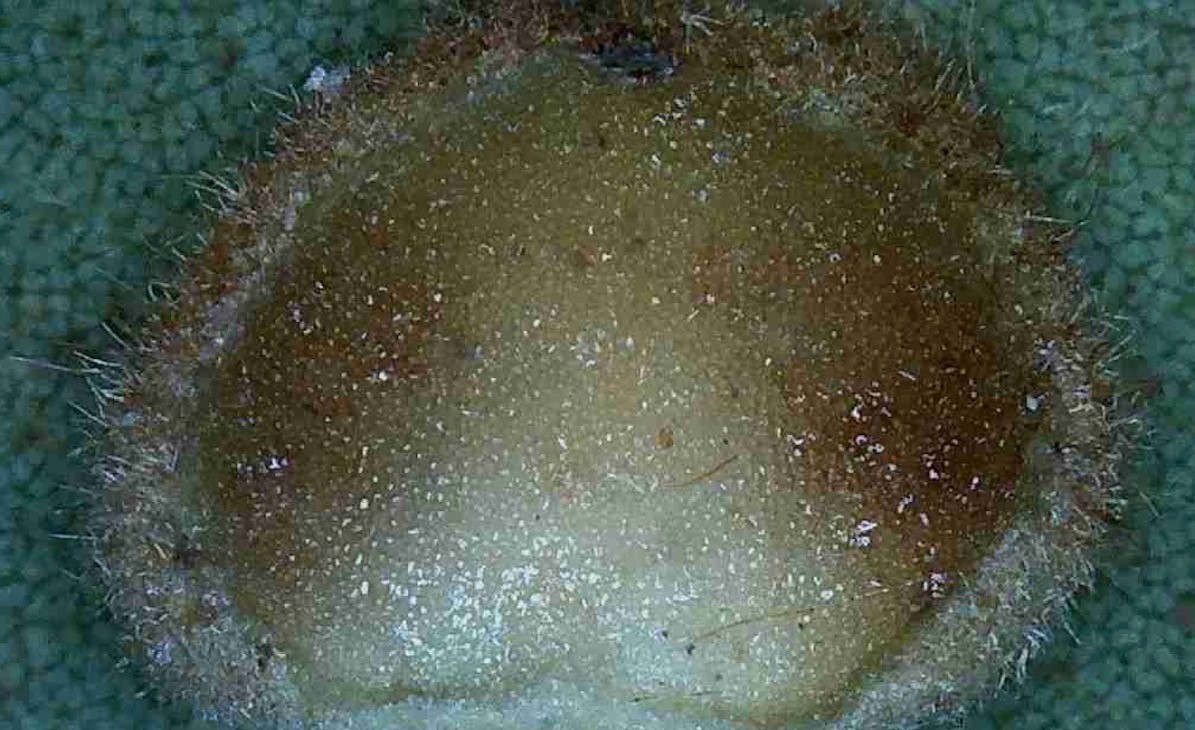
A hickory gall has been cut in half to show the leaf tissue.
The fungus can be lessened by good cultural practices and appropriate fungicidal applications. Please remember it is best left to professionals when spraying a large tree. This alone is not cause to remove your tree.
Hickory gall is caused by the hickory midge fly, an insect that lays eggs in the leaf tissue. The plant responds by building up tissue around each egg almost like the oyster when forming a pearl.
As the gall tissue grows, eggs hatch and larva start to feed on this tissue. The larva will continue to
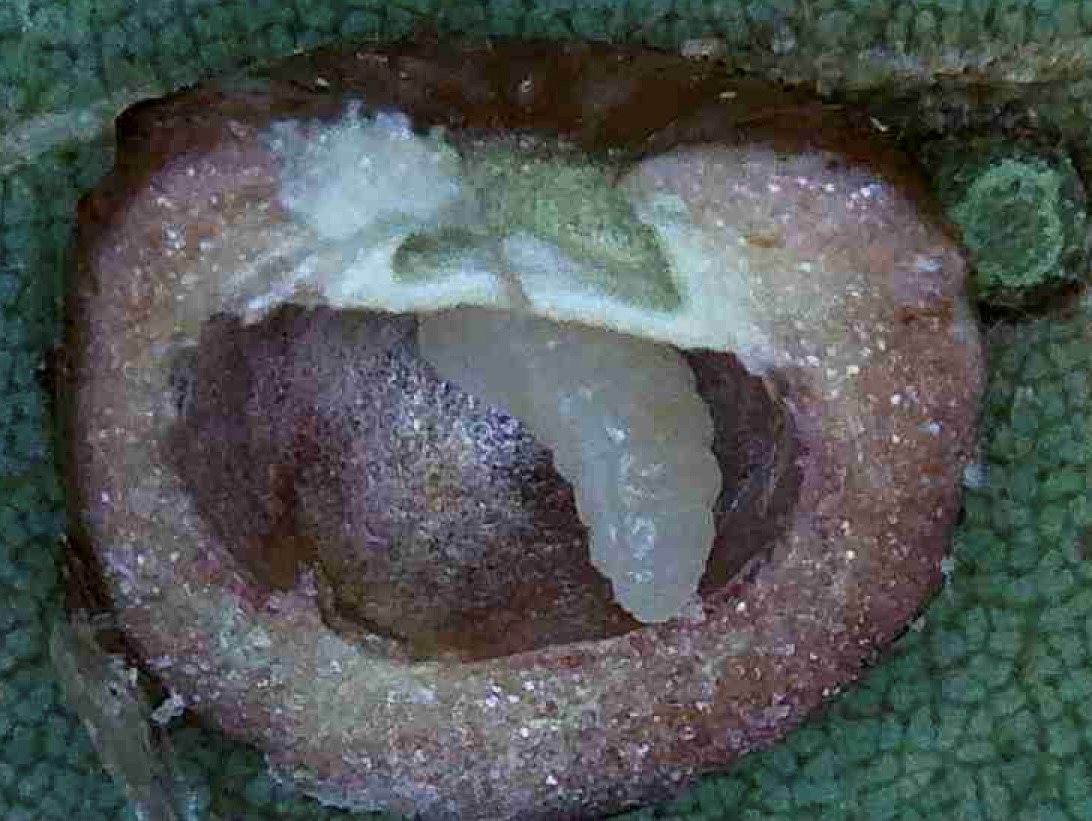
The larva has eaten all soft material inside the gall and is ready to pupate.
feed until it is ready to pupate within the gall. After forming a pupa, the midge fly will eventually emerge as an adult and females will continue to lay eggs on other leaves. The galls are more of a cosmetic damage and because your hickory leaves will fall from the tree as winter comes, the galls will normally not cause enough damage to worry about each year. Once again good cultural practices and disposal of each year’s leaves will reduce the gall numbers next year.
In a large tree with many leaves, foliar feeding by beetles and caterpillars do cause damage though the leaves will still produce enough food (photosynthesis) to keep the tree alive. Most of us never climb our trees to look at leaves to see the small insects/mites and there are more than enough leaves to maintain tree health.
The biggest concern during my site visit was their tree’s bacterial infection. A knife blade was pushed into the wound area and went in less than 1/4″. The homeowner was instructed to look at bactericide applications. In the end, this hickory tree with so many problems is still shading the home and helping cool the house. It is still giving refuge to wildlife and beneficial insects. When in doubt give our trees the benefit and keep them in place. Remember your local Extension agent is set up to make site visits and saving a tree is time well spent.
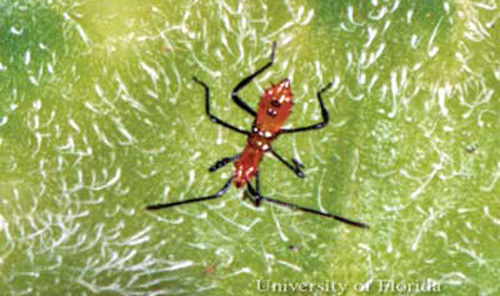
by Matthew Orwat | Mar 25, 2021
Stinkbugs and their relatives are not always problematic in the flower or vegetable garden, but when they become so, they can suck the life out of our fruits and vegetables, create ugly abrasions, and destroy flowers such as roses.
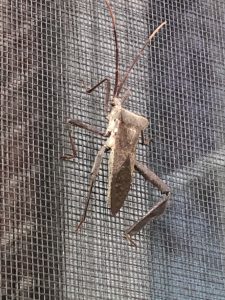
Over-wintering adult leaffooted bug emerging from hibernation . Image Credit Matthew Orwat, UF / IFAS Extension
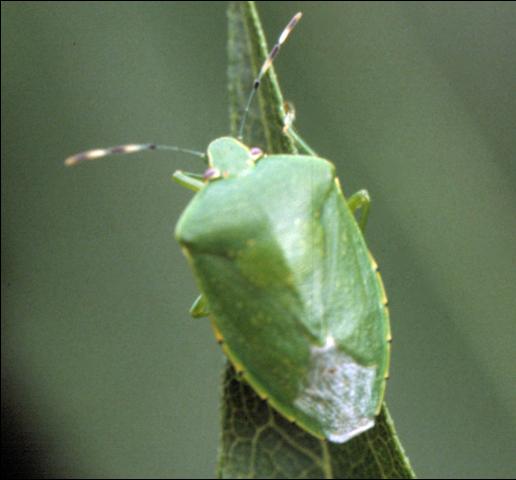
The green stink bug Acrosternum hilare (Say). Image and caption credit EDIS, Dr. Russ Mizell
What is a Stink Bug?
The stink bug (Pentatomidae family) is a major garden pest of a variety of fruits and vegetables including squash, peppers, tomatoes, peaches, plums, pecans and a variety of other edibles. They are known as a “piercing and sucking” insect because that’s the way they feed, by using their mouth, or proboscis, just like a needle to pierce the fruit and suck out the juices. This feeding leaves a damaged area of the fruit which may develop discoloration, rot or fungal disease and render the fruit unsaleable or inedible.
Who are “their relatives”
The leaf footed bug, Leptoglossus phyllopus (L), is a relative of the stinkbug and feeds in the same way, has a similar lifecycle and causes similar damage. They are usually slightly larger and have “leaf like” appendages on their legs which are their namesake.
What is their lifecycle?
In Florida, overwintering adult stink bugs will place a clutch, or tight group of eggs, on a host plant early in the growing season. If their preferred plant is not available, they use a variety of weeds and grasses to lay eggs upon and provide food for their young. After eggs hatch, they go through several nymph stages before they finally reach the adult stage. Stink bugs have multiple generations in a year, often four to five. They readily move to find preferable food sources and might appear in a garden without warning to feed and cause destruction.

Nymph of the leaffooted bug, Leptoglossus phyllopus (L.). Photograph by Lyle J. Buss, University of Florida.
How are they best controlled?
First of all, many stink bugs use weeds as host plants to gather and feed upon, so controlling weedy plants around vegetable and fruit gardens might limit their numbers. If stink bugs are a major problem, planting trap crops, such as sunflowers, is beneficial. Stink bugs prefer to feed on sunflowers more than some other vegetables. This situation can be used to the gardener’s advantage by mechanically killing or spraying stink bugs on trap crops while avoiding treating food crops with pesticides. More information on trap cropping can be found here.
Additionally, stink bug traps are available. These mechanically trap stink bugs, thus reducing their numbers in the garden, but need to be monitored and serviced regularly. Several species of parasitic Tachinid flies are also predators of stink bugs. These flies lay their eggs on adult stink bugs. The fly larva use the bug as a buffet, slowly killing the bug.
Stink bugs are difficult to control with insecticides, but some measure of control can be achieved at their nymph stage with various approved fruit and vegetable insecticides containing pyrethrins. These products are readily available at local garden centers and feed & seed stores.
For more information, please check out the following resources:
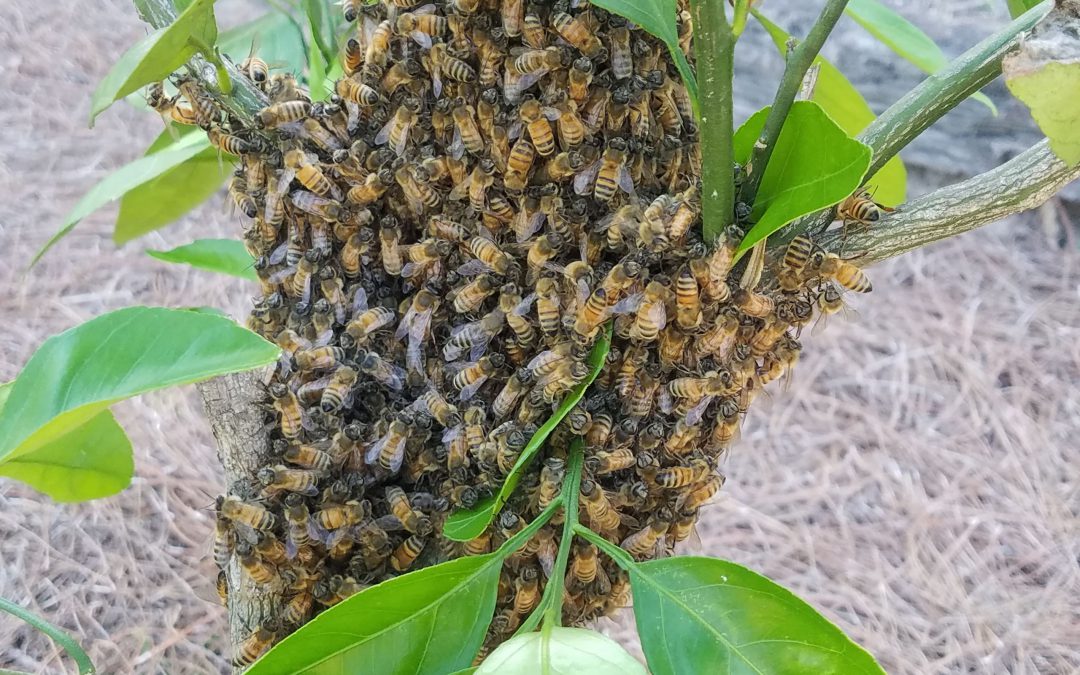
by Evan Anderson | Feb 25, 2021
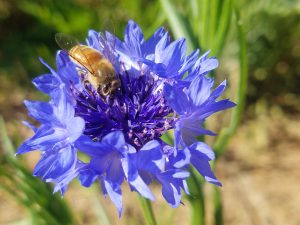
A worker bee gathering nectar and pollen.
As the weather warms, it seems that all kinds of living things start stirring. From birds to bees, plants to ants, and gnats to tourists, the world comes alive in the spring. It’s those bees we’ll discuss here, because every year they swarm, and that can cause some consternation among the homeowners whose houses they invade.
Honeybees are vitally important to our wellbeing, as they act as pollinators for many of our crops. They supply us with honey and wax and are a source of livelihood for many individuals. Important though they may be, they can sometimes become a nuisance.
Honeybees are eusocial organisms. Each honeybee lives in a colony or hive that it cannot survive without. In fact, it can be helpful to think of the entire hive as a single organism, even if it is made up of many individuals. The queen bee is the only one who lays eggs, but she cannot forage for her own food. Workers supply pollen and nectar to the hive but cannot reproduce on their own. Drones, or male bees, exist only to mate and would quickly die without the support of their sisters.
When a queen reproduces, she lays eggs that develop into new workers. When the time is right, she may lay eggs that develop into drones, or new females may be fed a substance called royal jelly that causes them to develop into new queens. These new drones and queens are born in preparation for a new hive to be created rather than to add more bees to the existing one. The old queen will be the adventurous one, so the workers put her on a diet. Once she has lost weight (to make it easier for her to fly), she takes half the workers in the hive and goes out in search of a new place to live. One of the new queens, after mating, returns to the nest and prepares to continue the work of her predecessor.
When the old queen leaves with her coterie, this is called a swarm. When weather warms and nectar begins to flow, the
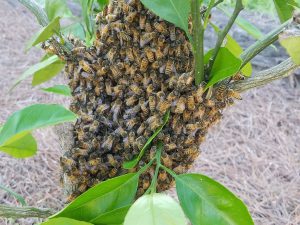
A swarm of bees looking for a new home.
bees travel from place to place looking for a good spot to live. Hollow cavities in trees are a favorite spot, but bee scouts often find what they think are perfect living places in our homes or sheds. While they are searching for a new place to set up shop, they may rest on trees or branches in large clumps. Do not be alarmed if you see one, as it does not mean they are nesting where they’ve stopped. Wait a while to see if they leave on their own or contact a local beekeeper to see if they want to collect the swarm.
If bees have taken up residence somewhere they’re not welcome, there are companies and individuals who may be able to collect the bees rather than destroying them. If removal is not an option, nuisance bees may be eradicated under Florida law, but this must be done by a certified Pest Control Operator.
If you have a swarm or hive on your property, check with the Department of Agriculture (Bee Removal or Eradication in Florida Resources) to find information and for a list of bee removal specialists. See our EDIS publication on choosing a pest control operator at Choosing the Right Pest Control Operator for Honey Bee Removal: A Consumer Guide. You can also contact your local Extension office for help with finding someone local.
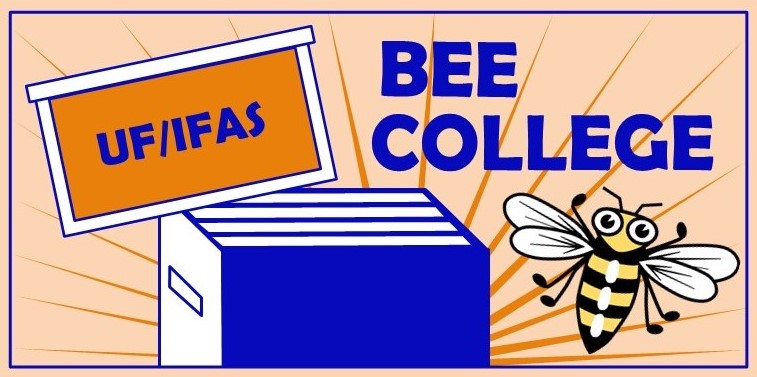
by Matthew Orwat | Feb 18, 2021
Join the University of Florida/Institute of Food and Agricultural Sciences (UF/IFAS) Honey Bee Research and Extension Laboratory for the 2021
Spring Virtual UF/IFAS Bee College! Imagine
FOUR Saturday mornings in March 2021 of all things honey bees. Those new to beekeeping can follow the beginner track, while more experienced beekeepers can participate in sessions focused on honey bee stressors and other advanced topics related to beekeeping. Speakers include UF/IFAS faculty, staff, students, members from the Florida State Beekeepers Association, specialists from Bee Informed Partnership, and other honey bee specialists around the world! Participants can choose to attend one session or all four as a
“Package Deal” for a reduced fee.
Register for the “Package Deal” or for each session separately– whatever works best with your schedule.
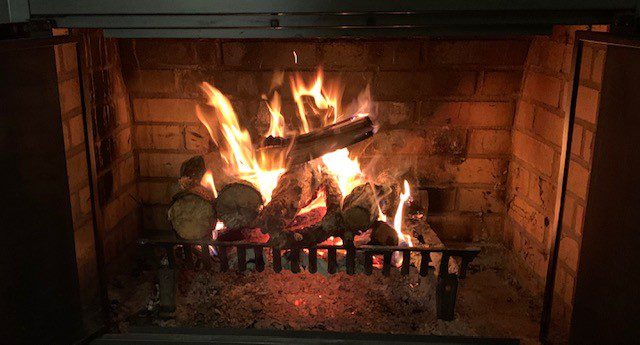
by Larry Williams | Feb 11, 2021
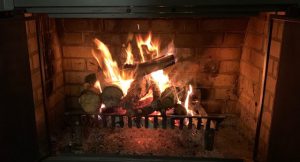
Be careful when bringing firewood indoors. Photo credit: Larry Williams
Your firewood pile could be “bugged.” Many insects like to overwinter in wood. A wood pile is an ideal place for some insects to survive the winter. They don’t know that you intend to bring their winter home indoors during cold weather.
During colder weather, you can unknowingly bring in pests such as spiders, beetles and roaches when you bring in firewood. It’s best to bring in firewood only when you are ready to use it. Otherwise, those pests could become active and start crawling around inside your house. Many insects are potential problems indoors and there are usually control options once insects move into your home. However, preventing the insects from getting inside is the best approach.
If you store wood indoors for short periods of time, it is a good idea to clean the storage area after you have used the wood. Using a first-in, first-out guideline as much as possible will reduce chances of insect problems.
It’s best to keep your wood pile off the ground and away from the house. This will make it less inviting to insects and help the wood dry. It’s not difficult to keep the wood off the ground. The wood can be stacked on a base of wooden pallets, bricks or blocks, which will allow air movement under the wood. The wood can also be covered with a waterproof tarp or stored in a shed. Regardless of how it is stored, avoid spraying firewood with insecticides. When burned, insecticide treated wood may give off harmful fumes.
Some critters that live in firewood can be harmful to humans. To avoid a painful sting or bite from insects, spiders or scorpions (no Florida scorpion is considered poisonous, but they can inflict a painful sting), it is a good practice to wear gloves when picking up logs from a wood pile.
Firewood can be a good source of heat during our cold weather. If you’re careful with how you handle your firewood, hopefully it will warm you, not “bug” you.













